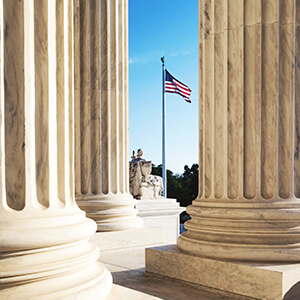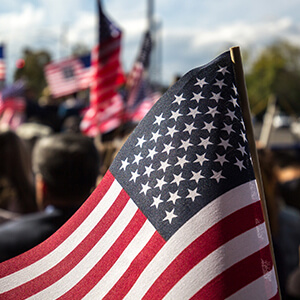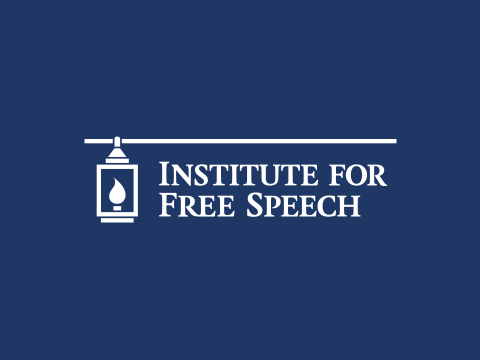Air America Media President Mark Green took to the digital pages of The Huffington Post today to wail about the pending Supreme Court decision in Citizens United v. FEC.
Green’s piece provides an illuminating look into the mind of the campaign finance reformer, and I’ll summarize the tactics behind the “reform” talking points in Citizen United v. FEC:
Make up stuff and spew hyperbole: a ten point plan
1. Pretend that the Supreme Court is about to overrule “100 years of federal laws restricting corporate campaign contributions.”
— Pretty much everyone in the pro-regulation crowd realizes that the Tillman Act of 1907 prohibited direct corporate contributions to campaigns, not the independent expenditures at issue in Citizens United v. FEC. For the campaign finance law impaired, a direct contribution is when a person or group (such as an incorporated entity in some states that allow corporate contributions) gives a political campaign money to fund its operations. At issue in Citizens United, however, are independent expenditures: TV ads, direct mail and other expenditures produced by a group independent of a candidate. Independent expenditures by corporations and unions were not upheld by the Supreme Court until its 1990 decision in Austin v. Chamber of Commerce. But, “100 years of precedent,” sounds better; so, just run with that.
2. Toss around random stats about money in politics like “we have a compromised democracy when .1 percent of Americans who contribute $1,000 or more in federal elections have more influence that the other 99 percent.”
— Never mind that three out of four studies on the influence of money in politics shows that campaign contributions do not buy votes or undue legislative influence. It’s a good line.
3. Throw out random stats about the enormous amount of money corporations will supposedly pour into political races, “say, $10 million to defeat a sitting legislator.”
— Sen. Russ Feingold is fond of saying that corporations could unleash a war chest of $23.5 trillion on our political system, referring to the net worth of U.S. corporations. As CCP President Sean Parnell explained, “In order to believe in the $23.5 trillion corporate piggy bank, you would need to believe that ExxonMobil is going to sell off all of its oil rigs and leases, and Pfizer is going to sell all of their laboratories and production facilities, and Wal-Mart is going to sell off all their stores, and the rest of corporate America is going to do likewise by selling their assets, and then they are going to use the sales proceeds to pay for independent expenditures.” So… it might be best to avoid the $23.5 trillion figure, but it’s good to just throw out a big, round number, say, $10 million, and say some dastardly corporation is going to spend that money to knock out everyone’s favorite Congressman. I mean, there’s readily-available data on the amount of soft money contributions corporations made before 2002 (no corporation spent more than $9.3 million in 2002) and the amount businesses contributed to 527s in recent years (2 percent of donations in 2007), but it’s a lot more fun to just make up numbers.
4. Pretend that Austin v. Michigan Chamber of Commerce, the main precedent at issue in Citizens United, was only one in a long line of precedents upholding Tillman: “The law, as later amended and strengthened, was last conclusively upheld in the 1990 case of Austin v. Michigan Chamber of Commerce as the Court majority reasoned that ‘corporate wealth can unfairly influence elections.'”
— Austin is not the “last” case in some long line of precedent to uphold a ban on corporate independent spending. It is the only such case. See point No. 1. But the hint of longevity, tough demonstrably false, makes the argument more dramatic…
5. Refer to core First Amendment freedoms, like groups spending money on independent political advocacy, as a “loophole” and say money is spent “independently.”
— Mocking the constitutional right to free speech is fun!
6. Right after bemoaning that the Court might overrule the 1990 precedent of Austin v. Michigan Chamber of Commerce (or, let’s be charitable and assume that reformers really believe the Tillman Act is the 100-year precedent at issue), explain why the Court should instead overrule a 120+-year precedent.
— Dredge up the 1886 case of Santa Clara County v. Southern Pacific Railroad Co., to explain why the Supreme Court never meant to give corporations the legal distinction of personhood. Provide no explanation for why this long-standing precedent is less-sacred that the fake 100-year precedent of the Tillman Act or the 20-year precedent in Austin.
7. While on the topic of criticizing precedents, go after the 1976 precedent in Buckley v. Valeo (14 years before Austin), which provides the foundation for modern campaign finance jurisprudence: “in a poorly reasoned decision… a 6-3 Court concluded that while donations could be restricted as potentially corrupting, there should be no ceiling on expenditures since that could be like limiting speech itself…”
— Green deciphers the meaning of Buckley v. Valeo into the “reform” straw man: money = speech. He then asks whether “… laws against bribery are unconstitutional because the payment of money to a decision-maker is mere speech.” Of course, refuting such a childish argument almost seems self-evident, but here it goes: money is not speech, but effective speech requires money. Speaking to potential voters on an issue or an election, whether independently or through a political campaign, requires money. Therefore, limiting money in politics limits First Amendment freedoms. Try telling a newspaper that the government can limit how much it spends on newsprint or the salaries of its reporters without violating their First Amendment rights. But, forget all that… it’s easier to demolish a straw man than build a solid argument!
8. In writing about why corporations should not have First Amendment rights, totally ignore that fact that the author is publishing the article through a media corporation and is employed by another media corporation (Air America Media).
— The editorial boards of The New York Times, Boston Globe and other newspapers have made similar arguments that First Amendment rights should not extend to corporations while ignoring the fact that their very livelihoods depend on media corporations’ First Amendment rights. As CCP recently wrote, “Of course, the media exemption — one might call it a ‘special legal status’ — in McCain-Feingold makes this NYT Co. regulation functionally impossible, because Congress decided to allow the institutional media to keep its First Amendment rights in politics (how kind of them). This construction, though, allows the government to decide who belongs to the press, thus bestowing them First Amendment rights. Is Michael Moore a muckraking documentary filmmaker or a political provocateur using corporate or union influence improperly? Let’s let the FEC spend a couple years probing around his finances to find out. If the AFL-CIO and MSNBC produce two documentaries on why Republican presidential candidate X is bad for working men and women that are 98 percent similar, is one more deserving of First Amendment protection than the other?”
9. While ignoring the media corporation implications of the argument that corporations should not have First Amendment protections, ignore that this ruling doesn’t solely impact multi-national business corporations but also affects unions and non-profit corporations.
— It’s important not to mention that a broad ruling in Citizens United would also restore First Amendment rights to unions and non-profit corporations like Citizens United. Better to just focus on the corporate bogeymen…
10. Compare Citizens United to Dred Scott v. Sandford: “…our generation’s campaign finance Dred Scott.”
— Yes, clearly a despicable 1857 Supreme Court ruling that African American slaves were not protected by the U.S. Constitution, slaves could never become citizens and the federal government could not prohibit slavery is analogous to a potential ruling that business corporations, unions and non-profits can spend money on independent expenditures. That’ll win people over.
11. Refer to the 2003 Supreme Court case McConnell v. FEC as “McDonnell.”
— Okay, now we’re just taking potshots…












